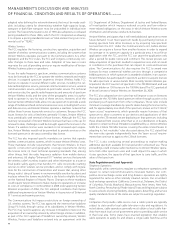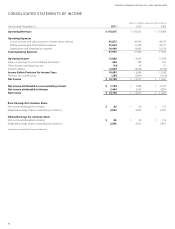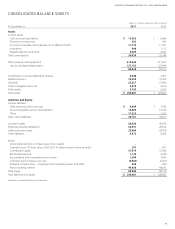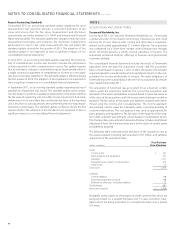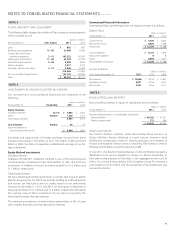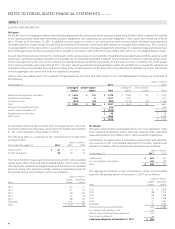Verizon Wireless 2011 Annual Report Download - page 59
Download and view the complete annual report
Please find page 59 of the 2011 Verizon Wireless annual report below. You can navigate through the pages in the report by either clicking on the pages listed below, or by using the keyword search tool below to find specific information within the annual report.nOtEs tO cOnsOlidatEd Financial statEMEnts continued
57
the amount that is not contingent upon providing additional services.
For equipment sales, we currently subsidize the cost of wireless devices.
The amount of this subsidy is generally contingent on the arrangement
and terms selected by the customer. The equipment revenue is recog-
nized up to the amount collected when the wireless device is sold.
Wireline
Our Wireline segment earns revenue based upon usage of its network
and facilities and contract fees. In general, fixed monthly fees for voice,
video, data and certain other services are billed one month in advance
and recognized when earned. Revenue from services that are not fixed in
amount and are based on usage is generally billed in arrears and recog-
nized when service is rendered.
We sell each of the services offered in bundled arrangements (i.e., voice,
video and data), as well as separately; therefore each product or service
has a standalone selling price. For these arrangements revenue is allo-
cated to each deliverable using a relative selling price method. Under this
method, arrangement consideration is allocated to each separate deliver-
able based on our standalone selling price for each product or service.
These services include FiOS services, individually or in bundles, and High
Speed Internet.
When we bundle equipment with maintenance and monitoring services,
we recognize equipment revenue when the equipment is installed in
accordance with contractual specifications and ready for the customer’s
use. The maintenance and monitoring services are recognized monthly
over the term of the contract as we provide the services. Long-term con-
tracts for network installation are accounted for using the percentage
of completion method. We use the completed contract method if we
cannot estimate the costs with a reasonable degree of reliability.
Installation related fees, along with the associated costs up to but not
exceeding these fees, are deferred and amortized over the estimated cus-
tomer relationship period.
We report taxes imposed by governmental authorities on revenue-pro-
ducing transactions between us and our customers on a net basis.
Discontinued Operations, Assets Held for Sale, and Sales of
Businesses and Investments
We classify as discontinued operations for all periods presented any com-
ponent of our business that we hold for sale that has operations and
cash flows that are clearly distinguishable operationally and for financial
reporting purposes.
Maintenance and Repairs
We charge the cost of maintenance and repairs, including the cost of
replacing minor items not constituting substantial betterments, princi-
pally to Cost of services and sales as these costs are incurred.
Advertising Costs
Costs for advertising products and services as well as other promotional
and sponsorship costs are charged to Selling, general and administrative
expense in the periods in which they are incurred (see Note 15).
Earnings Per Common Share
Basic earnings per common share are based on the weighted-average
number of shares outstanding during the period. Where appropriate,
diluted earnings per common share include the dilutive effect of shares
issuable under our stock-based compensation plans.
There were a total of approximately 6 million and 3 million stock options
and restricted stock units outstanding to purchase shares included in the
computation of diluted earnings per common share for the years ended
December 31, 2011 and December 31, 2010, respectively. Dilutive stock
options outstanding to purchase shares included in the computation
of diluted earnings per common share for the year ended December
31, 2009 were not significant. Outstanding options to purchase shares
that were not included in the computation of diluted earnings per
common share because to do so would have been anti-dilutive for the
period, included approximately 19 million, 73 million and 112 million
weighted-average shares for the years ended December 31, 2011, 2010
and 2009, respectively.
We are authorized to issue up to 4.25 billion and 250 million shares of
common stock and Series Preferred Stock, respectively.
Cash and Cash Equivalents
We consider all highly liquid investments with a maturity of 90 days or
less when purchased to be cash equivalents. Cash equivalents are stated
at cost, which approximates quoted market value and include amounts
held in money market funds.
Marketable Securities
We have investments in marketable securities, which are considered
“available-for-sale” under the provisions of the accounting standard for
certain debt and equity securities, and are included in the accompanying
consolidated balance sheets in Short-term investments, Investments
in unconsolidated businesses or Other assets. We continually evaluate
our investments in marketable securities for impairment due to
declines in market value considered to be other-than-temporary. That
evaluation includes, in addition to persistent, declining stock prices,
general economic and company-specific evaluations. In the event of a
determination that a decline in market value is other-than-temporary, a
charge to earnings is recorded for the loss, and a new cost basis in the
investment is established.
Inventories
Inventory consists of wireless and wireline equipment held for sale,
which is carried at the lower of cost (determined principally on either an
average cost or first-in, first-out basis) or market.
Plant and Depreciation
We record plant, property and equipment at cost. Our local telephone
operations’ depreciation expense is principally based on the composite
group remaining life method and straight-line composite rates. This
method provides for the recognition of the cost of the remaining net
investment in local telephone plant, less anticipated net salvage value,
over the remaining asset lives. This method requires the periodic revision
of depreciation rates. Plant, property and equipment of other wireline
and wireless operations are generally depreciated on a straight-line basis.
Leasehold improvements are amortized over the shorter of the estimated
life of the improvement or the remaining term of the lease in which the
asset is located, calculated from the time the asset was placed in service.
When we replace, retire or otherwise dispose of depreciable plant used
in our local telephone network, we deduct the carrying amount of such
plant from the respective accounts and charge it to accumulated depre-
ciation. When the depreciable assets of our other wireline and wireless



